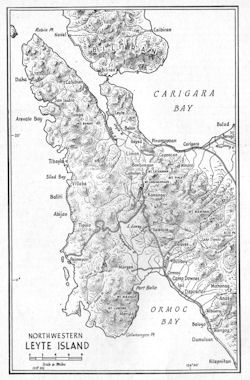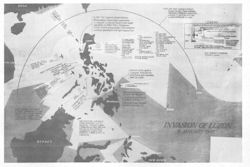
The Philippines--ORMOC, MINDORO
OCCUPATION OF ORMOC
At the beginning of December, 1944, our forces had
cleared the Japanese from most of eastern Leyte and were moving westward
through the central mountain range. The enemy still held the western part of the
island, including all of the Ormoc corridor, except Limon at the north, with
about 35,000 troops. They were being supplied through the port of Ormoc. On 6
December, a Task Group left Leyte Gulf and proceeded without incident to Ormoc
Bay, The beaches selected for landing extended from three to four miles to the
southwest of the town of Ormoc, The minesweepers preceded the rest of the group
and cleared a channel in Canigat West Pass on the 6th. After a 20 minute
bombardment by destroyers and rocket craft, the troops of the 77th Division were
landed beginning at 0707 and by 0900 all vessels were unloaded except one LSM
and one LCI which had been stranded on a reef. Enemy air attacks began at 0940
and the Mahan (DD) and Ward (APD) were damaged by suicide attacks and had to be
sunk by our own gunfire. Suicide attacks continued while the attack group was
forming up for return to Leyte Gulf. On 7 and 11 December the Japanese made
efforts to reinforce their troops on Leyte but both convoys were intercepted by
Marine and Army aircraft and several enemy vessels were sunk, although some
enemy craft succeeded in landing troops and supplies at west coast ports on
Leyte, A re-supply echelon arrived off Ormoc about 2300 on the 11th. It was
attacked by suicide aircraft and the Reid (DD) was sunk. There was heavy machine
gun and light artillery fire after the landing craft had neared the beaches but
no damage was done. As the convoy was retiring on the 12th it was attacked by
some 30 enemy aircraft, 16 of which were shot down by combat air patrols and
ship's gunfire.
--159--

NORTHWESTERN LEYTE ISLAND
--160--
MINDORO--PHILIPPINES
EARLY OPPOSITION NEGLIGIBLE
Because of adverse weather conditions at Leyte
airfields and unexpectedly strong enemy air reaction, control of the
air over Leyte was not complete on 5 December, the date set for the original
Mindoro landings. The date was, therefore, advanced to 15 December. The
objective was to provide dry-weather airfields to support future large scale
landings on Luzon. Heavy forces of assault troops were not necessary as only
about 200 enemy troops were thought to be in the landing area and not more than
500 on the entire island. During passage to the beaches there was much enemy air
opposition and more air attacks developed during unloading at the beaches, when
two LST's were hit and set afire, and Howorth (DD) damaged by suicide attacks.
Altogether 33 enemy planes were shot down in these attacks. No mines were found
by the minesweepers and opposition at the beaches was negligible. Objectives
ashore were quickly taken and construction of airfields and roads begun
immediately. By 22 December the San Jose field was in operation for P-38's and
B-24's. On the 26th Japanese naval units bombarded shore positions on Mindoro
for an hour and then retired to the west. Several of our merchant ships off the
beachhead were damaged. Air attacks on the positions at Mindoro were made
repeatedly during the rest of December and ten enemy planes attacked a convoy on
the 28th, blowing up an ammunition ship and damaging another vessel. By the end
of the month about 373 enemy aircraft had attacked our Mindoro positions, of
which some 145 were reported destroyed.
FS-367 TAKES SURVIVORS FROM USS MARISPOSA
At about 1530 on 30 December, 1944, Japanese planes
began a sudden and devastating attack on shipping in San Jose harbor
sinking or damaging four ships. One enemy plane crash-dived the USS Arcturus, a
PT tender, which sank, A second made a low-level straffing and bombing attack on
a group of LST's unloading at White Beach, blowing the stern off one LST and
sinking it. The same plane then turned to seaward in the direction of the USS
Mariposa, a Liberty type converted oil tanker. The Coast Guard manned FS-367 was
anchored some three hundred yards away. Despite heavy fire from ships and shore
batteries the Japanese plane succeeded in crash diving the Mariposa, striking it
amidships from the port side and penetrating the cargo of high-octane gasoline.
The ship burst instantly into flame. A number of the ship's crew were blown or
jumped into the water and the FS-367 weighed anchor preparatory to going to her
assistance. As they were beginning to get under way, a third Japanese plane came
in for a low-level attack on destroyers patrolling outside the harbor. This
plane received a hit which set it afire and it crashed into the USS Gansevoort,
which immediately began to burn and settle into the water. The FS-367 proceeded
to the assistance of the Mariposa and began taking on survivors. She stayed
alongside until all survivors had been taken off and was then signalled to stand
off at a safer distance. At 2130 the USS Gansevoort launched two torpedoes into
the Mariposa. The FS-367 was preparing to move in order to avoid burning
gasoline from the Mariposa which was spreading over the bay, when the
Gansevoort, which was much nearer the fire, requested the 367 to come alongside
to take off its crew. By the time they reached the Gansevoort the gasoline had
spread to such an extent that the latter was in immediate danger of being
engulfed so instead of taking off personnel the FS-367 warped alongside and
began towing
--161--

INVASION OF LUZON
9 JANUARY 1945
--162--
them to safer anchorage. At this time another alert was
sounded and shortly thereafter a Japanese plane was shot down almost directly
overhead. The Gansevoort finally dropped anchor in seven fathoms of water
several hundred yards off White Beach. Next day she was abandoned by her crew in
a sinking condition. No casualties were suffered aboard the FS-367.
PALOMPON--PHILIPPINES
CHIEF PORT REMAINING ON LEYTE OCCUPIED
Palompon, the chief remaining port in Japanese
possession on Leyte was occupied by our ground forces on 25 December. Kanaga,
terminus of the road from Palompon on the Ormoc-Ponampoan highway, was also
occupied. We further sent a few sorties against enemy installations and barge
hideouts on Samar and the Camotes Islands. We suffered no losses on these
missions.
MARINDUQUE--PHILIPPINES
A STEP TOWard LUZON
Our landing on Marinduque Islands east of Northern
Mindoro on the morning of 3 January 1945, was in preparation for
Luzon operations. The island itself is of little value, being mountainous
and wooded, but it commands the eastern entrance to the Verde Island Passage
between Mindoro and the Batangas area of Luzon, as well as the Sibuyan Sea.
FAIS ISLAND--CAROLINES
FAIS ISLAND NOT USED AS AN ENEMY BASE
Suspecting that Fais Island, located a short distance
south and east of Ulithi might be a base for enemy midget submarines or a
communications center, a landing was made on the southeast beach on 1 January,
1945. The western half of the island was searched on the same day but no
Japanese were found. A more intense search on the 3rd brought contact with the
enemy in a cave in that part of the island and eight Japanese were killed
together with three of our men. When six Japanese civilians surrendered later it
was ascertained that only three of the enemy remained in the island. The radio
station and hospital were destroyed after removing all valuable equipment. The
American flag was raised on the 4th and the task force returned to Ulithi after
restoring the native king to his rule over the 280 natives. The island had never
been used as a submarine base, but the radio station had remained operative
until 24 December when the transmitter had gone out of commission.
--163--
Table of Contents
Previous Part (21) **
Next Part (23)


